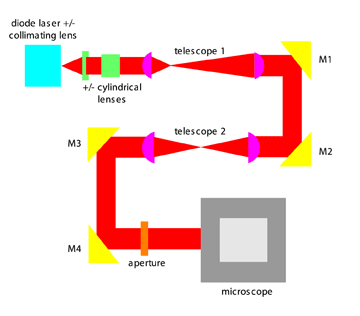Understanding the roles of, and interactions between, individual cells is important for elucidating both normal and pathological brain functioning. Analyzing single cells provides insight into cell-to-cell heterogeneity and prevents dilution of trace analytes by signals from compounds present in all cells. While both MALDI MS and capillary electrophoresis with laser-induced fluorescence (CE-LIF) have the ability to characterize the constituents in individual cells, isolating, selecting and sampling the cells can be difficult. Towards this goal, we are interfacing an optical trap with our CE-LIF systems. Our optical trap allows nanometer- to micrometer-sized particles, including single cells and organelles to be manipulated. This combination allows single cells and subcellular components to be injected with a minimum of background media, with the overall process minimizing analyte dilution and sample contact. |
The main components in the optical trap used to manipulate and inject cells are a near IR diode laser, cylindrical optics for correcting the beam properties, a telescope for expanding and controlling the beam, and a microscope with a high NA objective. The trap is used to move cells into the inlet end of the separation capillary. |


